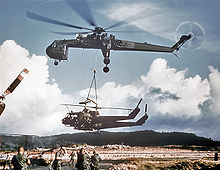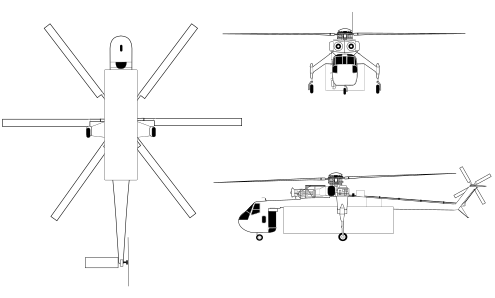Sikorsky CH-54 Tarhe
| CH-54 Tarhe | |
|---|---|

| |
| A CH-54A carrying a parachute bomb | |
| Role | Heavy-lift cargo helicopter |
| Manufacturer | Sikorsky Aircraft |
| First flight | 9 May 1962 |
| Retired | 1991 |
| Status | retired |
| Primary user | United States Army |
| Number built | 105 |
| Variants | S-64 Skycrane |


The Sikorsky CH-54 Tarhe is a twin-engine heavy-lift helicopter designed by Sikorsky Aircraft for the United States Army. It is named after Tarhe (whose nickname was "The Crane"), an 18th-century chief of the Wyandot Indian tribe.[1] The civil version is the S-64 Skycrane.
Development
Initial work on the Sikorsky "sky-crane" helicopters began in 1958 with the piston-engined Sikorsky S-60.
The first flight of the turboshaft-powered S-64 Skycrane was May 9, 1962,[2] with the U.S. Army eventually purchasing 105, designating them CH-54. Used in Vietnam for transport and downed-aircraft retrieval, it was highly successful, thanks to the 'adaptable' nature of the module system first conceived by General James M. Gavin in his book Airborne Warfare in 1947. Early pods could not carry troops and external sling-loads at the same time. Advanced pods for the CH-54 could carry troops and cargo underslung at the same time but were not purchased. The Skycrane can not only hold its cargo up and tight against its center spine to lessen drag and eliminate the pendulum effect when flying forward, it can winch vehicles up and down from a hovering position, so the helicopter itself did not need to land. Due to budget cuts the Heavy Lift Helicopter (HLH) program was canceled and the CH-54s not upgraded with larger engines. The Boeing CH-47 Chinook gradually supplemented it in combat and eventually replaced it in Regular Army aviation units, although CH-54 Skycranes remained in Army National Guard service until the early 1990s. The Soviet Union also created much larger crane helicopters with a similar skeletal design.
A CH-54B holds the record for highest level flight altitude: 36,122 feet (11,010 m)—piloted by James K. Church on 4 November 1971 in the USA.[3]
Today, Erickson Air-Crane of Central Point, Oregon operates the largest fleet of S-64 helicopters in the world under the name Erickson S-64 Aircrane, which can be equipped with water-dropping equipment (some also have foam/gel capability) for firefighting duties worldwide. After obtaining the type certificate and manufacturing rights in 1992, Erickson remains the manufacturer and world’s largest operator of S-64s.
Variants
- YCH-54A
- Pre-production aircraft, six built.[4]
- CH-54A
- Production model powered by two 4,500 shp (3,400 kW) Pratt & Whitney T73-P-1 turboshafts, 54 built.[4]
- CH-54B
- Heavier version of the CH-54A with two 4,800 shp (3,600 kW) T-73-P-700 turboshafts and twin-wheeled main undercarriage, 37 built.[4]
Operators
Survivors
A large number of surviving airframes exist in flyable condition as well as in museum collections worldwide.
Specifications (CH-54B)


Data from The Complete Encyclopedia of World Aircraft[5]
General characteristics
- Crew: 3
Performance
See also
Related development
Aircraft of comparable role, configuration, and era
Related lists
References
- ^ Ohio History Central page on Tarhe
- ^ Taylor 1976, p.386.
- ^ "Record File n°9918". Fédération Aéronautique Internationale. Retrieved 11 January 2011.
- ^ a b c Harding 1990, p.243.
- ^ Donald, D. (1997). "Sikorsky S-64 / CH-54 "Tarhe" helicopter". The Complete Encyclopedia of World Aircraft. Retrieved 2006-10-08.
- Francillon, René J. (Spring 1991). "The Army Guard's Weightlifter". World Air Power Journal. 5: 36–41.
- Harding, Stephen (1990). U.S. Army Aircraft Since 1947. Shrewsbury, UK: Airlife. ISBN 1-85310-102-8.
- Taylor, John W. R. (1976). Jane's All The World's Aircraft 1976–77. London: Jane's Yearbooks. ISBN 0-354-00538-3.
External links
- CH-54 U.S. Army Aviation history fact sheet
- CH-54 Skycrane/Tarhe on Global Security.org
- The short film STAFF FILM REPORT 66-2A (1966) is available for free viewing and download at the Internet Archive.
- The short film STAFF FILM REPORT 66-21A (1966) is available for free viewing and download at the Internet Archive.
